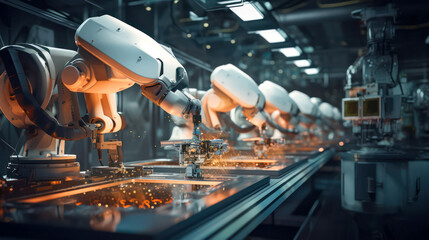
Precision Engineering: Robotic Automation Solutions
Introduction
Robotic automation solutions are revolutionizing precision engineering, offering unparalleled accuracy, efficiency, and repeatability in manufacturing processes. This article delves into how robotic automation is transforming precision engineering and shaping the future of manufacturing.
Outline
- Understanding Robotic Automation in Precision Engineering
- Applications and Use Cases
- Advantages and Benefits for Precision Engineering
- Challenges and Considerations
- Future Trends and Innovations
- Conclusion
- FAQs
Background
Understanding Robotic Automation in Precision Engineering: Robotic automation in precision engineering involves the use of robotic systems equipped with advanced sensors, actuators, and control algorithms to perform highly precise and intricate tasks such as machining, assembly, and inspection.
Applications and Use Cases
Robotic automation solutions find applications across various areas of precision engineering, including:
- Machining: Robots equipped with high-speed spindles and tool changers enable precise milling, turning, and grinding operations.
- Assembly: Collaborative robots (cobots) assist in delicate assembly tasks requiring high accuracy and repeatability.
- Inspection: Vision-guided robots perform detailed inspections of manufactured parts to detect defects and ensure quality standards are met.
Advantages and Benefits for Precision Engineering
The adoption of robotic automation in precision engineering offers several advantages, including:
- Enhanced Precision: Robots equipped with advanced sensors and control systems achieve sub-millimeter accuracy, surpassing human capabilities.
- Increased Efficiency: Automated processes reduce cycle times and enable continuous operation, leading to higher throughput and productivity.
- Improved Quality Control: Robotic inspection systems ensure consistent quality by detecting defects and deviations with greater accuracy and reliability.
- Cost Savings: Automation reduces labor costs and material waste while optimizing resource utilization, resulting in overall cost savings for manufacturers.
Challenges and Considerations
Despite the benefits, implementing robotic automation in precision engineering comes with challenges such as:
- Complexity: Integrating robotic systems with existing workflows and infrastructure requires careful planning and expertise.
- Programming and Maintenance: Robotic programming and maintenance tasks demand specialized skills and ongoing support to ensure optimal performance.
- Safety Concerns: Working alongside robots poses safety risks to human operators, necessitating robust safety protocols and risk assessments.
Future Trends and Innovations
The future of robotic automation in precision engineering is marked by advancements in areas such as:
- Artificial Intelligence: AI-powered robots capable of adaptive learning and decision-making enhance flexibility and responsiveness in manufacturing processes.
- Human-Robot Collaboration: Collaborative robots designed to work safely alongside humans enable new applications and workflows in precision engineering.
- Advanced Sensing Technologies: Integration of advanced sensors, such as 3D vision systems and force/torque sensors, improves robot perception and interaction capabilities.
Conclusion
Robotic automation solutions are driving significant advancements in precision engineering, offering unmatched levels of accuracy, efficiency, and quality. As technology continues to evolve, manufacturers must embrace innovation and adapt to stay competitive in the rapidly changing landscape of precision manufacturing.
FAQs
Q: How can manufacturers determine the suitability of robotic automation for their precision engineering processes?
A: Manufacturers should conduct a thorough analysis of their processes, considering factors such as complexity, volume, and required precision, to determine the feasibility and potential benefits of robotic automation.
Q: What are some emerging applications of collaborative robots (cobots) in precision engineering?
A: Emerging applications include cobots assisting in intricate assembly tasks, collaborative machining operations, and human-robot collaboration in small-batch manufacturing environments.
Q: How can manufacturers address the skills gap in robotic programming and maintenance for precision engineering applications?
A: Manufacturers can invest in training programs, collaborate with educational institutions, and leverage external expertise from robotics integrators or service providers to bridge the skills gap and build internal capabilities.











